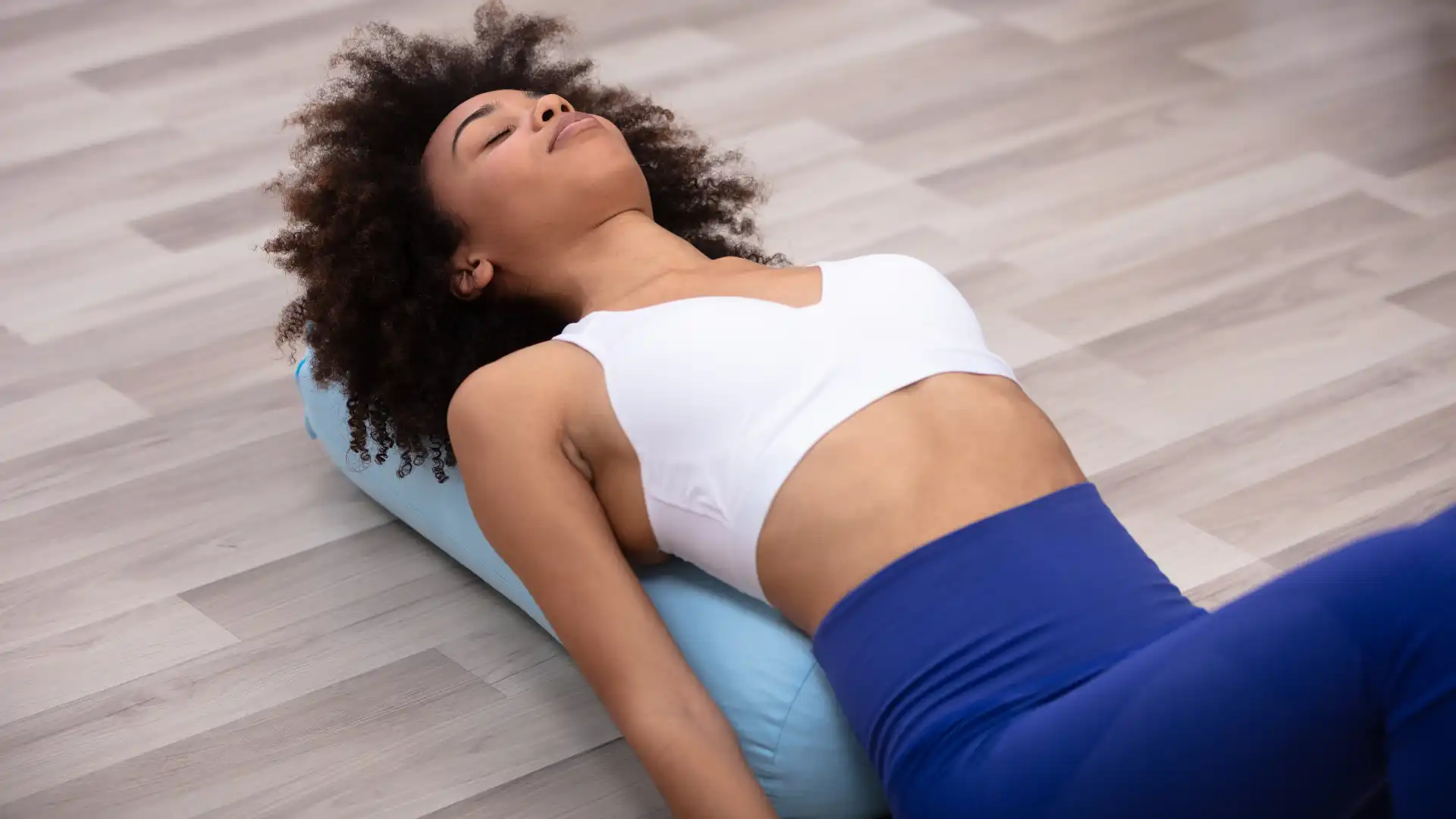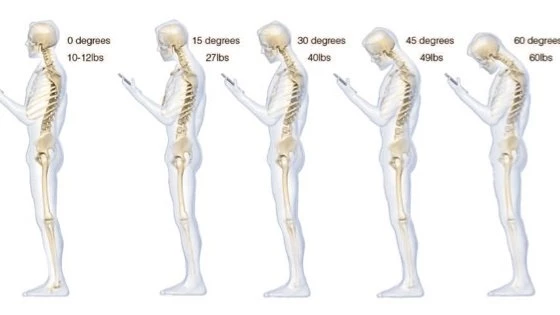Yoga for Back Pain: Are Your Tech Devices Ruining Your Posture?

Tech devices are here to stay, but increasing evidence shows they can also wreak havoc on your body and lead to serious back pain issues. Physical therapist and yoga teacher Stefanie Foster offers insights into the damaging effects of tech devices on your posture, and how yoga can help you prevent the back pain issues that often result from chronic forward head posture.
 Several news articles popped up after an article in a surgical journal highlighted how peering down at our tech devices increases loads on our spine. Many of you may be thinking that most extreme 60-degree, 60-pound force looks like some teenagers you know!
Several news articles popped up after an article in a surgical journal highlighted how peering down at our tech devices increases loads on our spine. Many of you may be thinking that most extreme 60-degree, 60-pound force looks like some teenagers you know!
But it’s not just teenagers. If you go out in public, and take long enough to look up from your own smart phone, it’s all around you! People of all ages have their head down in tech devices.
Maybe you say, “That’s not me, I keep my head up straight and just look down with my eyes…” Another study, published before smart phones and tablets were so ubiquitous, suggests that merely gazing down with posture controlled was enough to increase spinal loading.
The Dangers of Forward Head Posture
So why all the fuss? Because this is not just a one-time loading (although, I’d be hesitant to let a 60-pound kid sit on the back of my neck!). This is a repetitive position or sustained posture that we find ourselves in over and over again. And the more prolonged or more frequently our body does the same thing, the easier it gets.
The muscles on the front get short and/or lazy; muscles, ligaments and fascia on the back side become too lengthened to do their job effectively, and over a period of years, the shapes of the bones may begin to wedge and adapt to that position as well. As in a previous article, the body follows the path of least resistance just like any other mechanical system…ask your high school physics teacher!
And so, without intervention, the short gets shorter, the stiff gets stiffer, the long gets longer, and the weak gets weaker.
 Now, imagine a day in the life of Bob: Bob wakes up and reads the paper over breakfast (he’s old fashioned like that.) Then, he boards the train to work, reading articles and emails on his iPad the whole way. At work, he spends much of the day peering down at a laptop screen.
Now, imagine a day in the life of Bob: Bob wakes up and reads the paper over breakfast (he’s old fashioned like that.) Then, he boards the train to work, reading articles and emails on his iPad the whole way. At work, he spends much of the day peering down at a laptop screen.
After work he heads to his CrossFit box where his favorite WOD involves as many sit-ups as he can accomplish in a timed effort. One of Bob’s friends recommended that he try yoga, so he catches a class after CrossFit. He’s been going for about four months now and really feels like he’s getting the hang of it.
After a vigorous class (involving more crunch-like ab exercises), the teacher invites the students to enter into “the queen of all yoga postures” Salamba Sarvangasana or Shoulderstand, “if it is in your practice.” Bob looks at what everyone’s doing, remembers that he used to do that as a kid and effortlessly throws himself up into Shoulderstand.
After yoga, he heads home, spends more time on his laptop, then reads a bit in bed before going to sleep. The next morning, he wakes up with a splitting headache and a sore neck and can’t imagine why!
Ok, so maybe one time of doing Shoulderstand won’t necessarily send Bob reeling. But, it can happen! It’s not just that Shoulderstand though, is it?
Bob has been practicing all of those other postures of prolonged forward head position (reading the paper, his iPad, laptop, reading in bed) for far longer than his Shoulderstand. And thus, he set himself up for the relative stiffness/flexibility imbalance that comes with it.
Problems with this Scenerio
There are a few more problems I see with this picture. Did you catch them?
-
Many ab exercises further exacerbate a slouching (flexion) of the upper (thoracic) spine by contributing to a shortening of the abdominal muscles that create stiffness from the ribcage to the pelvis. (5)
-
The teacher glorified Shoulderstand in front of an all-levels class by calling it “the queen of all yoga postures.” I’m well aware that this is oft stated in the yoga community. (If anyone can tell me the original source, I’d love to know!) However, how can the yoga practitioner cultivate equanimity when they’re hearing they’re less of a yogi if they don’t do Shoulderstand?
-
The teacher said “if it is in your practice.” This statement is one of my pet peeves. It is meant with good intention. In a typical all-levels class, a teacher cannot be expected to monitor every single student and give each of them something to work on appropriate for their current needs. The teacher is intending for the students to self-assess their abilities, and needs and choose what is appropriate. Teachers should know better than to think that a human being, with an ego and a mildly competitive spirit, in their first year of yoga will decide appropriately what they’re ready for. In fact, I remember back to my first year of yoga practice…Shoulderstand was the first inversion I practiced on a regular basis! Some of you may be gasping in horror, while others may be asking yourself “what’s wrong with that?”
Solutions to Using Shouldertstand (Sarvangasana) to Combat Text Neck
“If you practice Shoulderstand properly you have nothing to worry about” = Wrong.
-
I can hear some experienced yoga practitioners saying, “Well, if you do Shoulderstand properly, you don’t put any pressure on your spine at all.” Point taken. And I will agree that a properly performed Shoulderstand is certainly better than Bob (and beginner me) throwing himself into what looked like the pose on the outside. However, just because the spinous processes of your vertebrae don’t touch the ground, doesn’t mean you’re exempt from the forces of gravity going through your spine at very different points than they’re designed for. Look at the picture of smart phone guy again: that 60 pounds of force is not coming from direct pressure on his vertebrae.
-
“I always do Shoulderstand with props, never without.” Good. Especially if you are practicing longer holds. But, even if you have your shoulders on several blankets, your head is still forward, even if you are working to maintain a neutral curve or normal lordosis in your neck. Although I don’t know of anyone who has studied it, I’d bet even if you turned the middle smart phone guy upside down with his head on the ground rather than his feet, and supported his shoulders on blankets, there would be more than 40 pounds of pressure at that point. Plus, I’m willing to bet that Iyengar didn’t spend the rest of his day when he wasn’t practicing yoga hovering his head over a tech device. I would also bet that if he ever got injured, it wasn’t publicized. *gasp!*
“As long as you include a counterpose, you have nothing to worry about” = Wrong.
-
I understand the thought process here, that the counterpose somehow cancels out what you just did, but it’s not that simple. What then is the counterpose for 10+ hours a day we spend with our heads forward? Things like Fish Pose (Matsyasana), gazing up in Urdvha Hastasana (Upward Salute), taking the head back in Cobra or Up Dog, looking between the hands in forearm stand or handstand are not going to magically undo what we’ve done in daily activities and Shoulderstand or Plow Pose.
-
One reason is that it’s more than just our muscles, ligaments and fascia that get stretched in that forward head position. Our nerve tissue gets stretched as well. In many individuals, this nerve tissue is sensitive and not relieved by backbending.
-
It’s not a rainbow-like forward bending curve most of us are creating in the neck. Most of the time, there’s a shear happening at the CT junction, or the part of your spine where the neck becomes the upper back. With this prolonged forward head position, the lower neck (cervical spine) begins to slide forward relative to the upper thoracic vertebrae creating a movement like a shifting tectonic plate. In this instance, going into cervical extension (like the counterposes mentioned above) may actually feel worse as there is increased pressure on the discs, joints and nerve roots.
Recommendations for Improving Posture with Yoga
-
Spend less time on your tech devices. We could all benefit from this, myself included! Batch process your messages rather than checking them constantly all day. Be with whomever is in the room with you live. Take your yoga mat and go outside.
-
When you do have to use tech devices, try to keep a neutral spine with normal curves and have viewing at eye level. Support your arms on a pillow if necessary to hold books or reading devices. If you do a lot of work on a laptop, consider a docking station or separate screen so you can have both gaze and arms at appropriate position. If you work from home, consider some alternatives such as lying on the floor part of the time.
-
Minimize forward head positioning at other times. (at meals, watching TV, while working out)
-
Recalibrate your relationship to “core work.” A six-pack may look nice, but it can work against your ability to maintain healthy spine positioning. Curling your spine into a “C” shape does nothing to improve central stability. Tucking your tailbone or posteriorly tilting your pelvis has also been shown to shut down your primary stabilizing team.
-
Learn what it feels like to engage your cervical core. No, I’m not talking about Jalandhara Bandha (Chin Lock). I’m talking about balanced stability around the neck and scapular stabilizers.
-
If you’re a yoga practitioner and not sure that you’re doing Shoulderstand “correctly,” or that you’re ready for it at all, work with an experienced teacher 1:1.
-
If you’re a yoga teacher, be mindful of your language as mentioned above. Consider that your students are “householder yogis” and doing all these things cumulatively outside your class. Teach your students what it means to have a healthy curve in the neck and to maintain it first in progressive heights of Bridge Pose (Setu Bandha Sarvangasana) before ever attempting Shoulderstand, whether with or without props. Hold firm authority in your yoga classroom that if anyone is doing Shoulderstand in an unsafe manner, you reserve the right to give them an alternative, or ask them to sit out the pose.
Reprinted with permission from asanaintelligence.com

Stefanie Foster, PT, FAAOMPT, PYT, WHNC is a licensed physical therapist passionate about teaching clients long-term solutions for self-care through a model which can be carried over as a lifestyle. Her philosophy is that if you are doing something you enjoy, you are more likely to integrate it into everyday life. She believes yoga allows her to educate clients and patients on asana with intelligence.
Sources
2. Wilson 2014. Your Smartphone is a Pain in the Neck. CNN Health.
3. Hansraj 2014. Assessment of Stresses in the Cervical Spine Caused by Posture and Position of the Head. Surgical Technology International.
4. Bonney 2002. Head posture and loading of the cervical spine. Applied Ergonomics.
5. Sahrmann 2002. Diagnosis and Treatment of Movement Impairment Syndromes.



